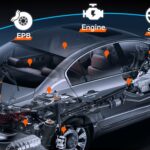Encountering “HCAT” on your OBD2 scanner can be perplexing if you’re not well-versed in automotive diagnostics. As a crucial component within your vehicle’s emissions control system, understanding the Hydrocarbon Adsorber Catalyst (HCAT) is key to ensuring your car runs efficiently and cleanly. This guide, brought to you by the auto repair experts at techcarusa.com, will clarify what HCAT signifies, its importance, and the necessary actions when an HCAT-related warning appears on your OBD2 scanner.
What Exactly is HCAT?
The acronym HCAT stands for Hydrocarbon Adsorber Catalyst. Essentially, the HCAT acts as a specialized filter within your vehicle’s exhaust system. Its primary function is to trap harmful hydrocarbon emissions, particularly during engine startup when combustion is less efficient.
When your engine is cold, it doesn’t burn fuel as completely as when it’s warm. This results in a higher output of unburned fuel, known as hydrocarbons. Without intervention, these hydrocarbons would escape directly into the atmosphere, contributing to air pollution. This is where the HCAT plays a vital role.
The HCAT is engineered to adsorb, or capture, these hydrocarbons. It holds onto them until the engine reaches its optimal operating temperature. Once warmed up, the HCAT releases the stored hydrocarbons. These released gases then proceed to the catalytic converter, another essential component of your car’s emissions system, where they are further processed and converted into less harmful substances. This entire process significantly reduces harmful emissions, ensuring your vehicle operates more environmentally friendly.
How OBD2 Scanners Detect HCAT Issues
Advanced OBD2 scanners, such as the Foxwell NT909, are invaluable tools for diagnosing HCAT-related problems. These scanners interface with your vehicle’s On-Board Diagnostics (OBD2) system, a sophisticated network that continuously monitors the performance of various vehicle systems, including the emissions control system and specifically the HCAT.
When you connect a diagnostic scanner like the Foxwell NT909 to your car’s OBD2 port, it establishes communication with the vehicle’s engine control unit (ECU). The ECU gathers real-time data from sensors strategically placed to monitor the HCAT’s efficiency. These sensors track critical parameters such as:
- Hydrocarbon Adsorption Rate: Measures how effectively the HCAT is capturing hydrocarbons.
- Exhaust Gas Temperature: Monitors the temperature within the exhaust system and around the HCAT, ensuring it’s within the optimal operating range.
- Catalyst Efficiency: Assesses the overall effectiveness of the HCAT in reducing emissions.
If any of these sensor readings deviate from pre-programmed acceptable ranges – for example, if the HCAT isn’t adsorbing hydrocarbons adequately or fails to reach the required temperature – the OBD2 system registers a fault. This fault triggers the generation of a Diagnostic Trouble Code (DTC). The Foxwell NT909, and other competent OBD2 scanners, can retrieve these DTCs, displaying them on the screen along with descriptions and potential causes. This detailed information empowers you to understand the nature of the problem and initiate appropriate troubleshooting or repair actions.
Decoding Common HCAT Related OBD2 Codes
When your OBD2 scanner, like the Foxwell NT909, identifies an issue with the HCAT, it will display specific fault codes. These codes serve as alerts, indicating potential malfunctions within the HCAT system that could negatively impact your vehicle’s emissions performance. Recognizing these codes is the first step towards effective diagnosis and repair. Here are some of the common OBD2 codes associated with HCAT problems:
-
P0420 – Catalyst System Efficiency Below Threshold (Bank 1): This is a frequently encountered code suggesting that the catalytic converter system on engine bank 1 (if applicable to your vehicle configuration) is not operating at the required efficiency level. While it broadly points to catalyst inefficiency, it can also be related to HCAT performance issues impacting the overall system efficiency.
-
P0430 – Catalyst System Efficiency Below Threshold (Bank 2): Similar to P0420, this code indicates reduced catalyst efficiency, but specifically for Bank 2 of the engine. Again, HCAT malfunction could be a contributing factor.
-
P0421 – Warm Up Catalyst Efficiency Below Threshold (Bank 1): This code directly points to inefficiency during the engine warm-up phase. It signals that the HCAT, which is crucial during cold starts, is not performing adequately to reduce emissions when the engine is still warming up.
-
P0431 – Warm Up Catalyst Efficiency Below Threshold (Bank 2): Analogous to P0421 but applicable to engine Bank 2. It also highlights issues with the HCAT’s performance during the engine warm-up cycle on the respective engine bank.
-
P0422 – Main Catalyst Efficiency Below Threshold: This code is less common but indicates a general inefficiency of the main catalytic converter system. While not exclusively an HCAT code, if the HCAT is malfunctioning and not pre-treating exhaust gases effectively, it can contribute to this code being triggered.
-
P0423 & P0424 – Catalyst Temperature Below/Above Threshold: These codes indicate temperature-related problems within the catalytic converter system. If the HCAT is not functioning correctly, it can affect the exhaust gas temperature entering the catalytic converter, potentially leading to these temperature threshold codes.
Receiving any of these codes on your OBD2 scanner is a clear indication that the HCAT or related components in your emissions system may be failing or underperforming. Addressing these issues promptly is crucial to prevent increased emissions, potential damage to other components, and ensure your vehicle remains compliant with environmental regulations.
Steps to Take When an HCAT Warning Appears
When your car scanner displays an HCAT warning or one of the related fault codes, swift action is essential to mitigate potential long-term problems. Here’s a step-by-step approach to address an HCAT warning:
-
Initial Inspection: Begin by visually inspecting the HCAT and surrounding exhaust system components. Check for any obvious signs of damage, such as leaks, cracks, or loose connections in the exhaust pipes, sensors, and wiring near the HCAT. Sometimes, a simple issue like a disconnected sensor wire can trigger a fault code.
-
Professional Diagnosis: If the warning persists after a visual check, or if you are not comfortable performing automotive diagnostics yourself, it’s best to seek professional assistance from a certified mechanic. They possess the specialized tools and expertise to accurately diagnose the root cause of the HCAT warning. Using advanced diagnostic equipment, they can perform thorough tests to pinpoint whether the HCAT itself is faulty, or if the issue stems from related components like sensors, wiring, or other parts of the emissions system.
-
Repair and/or Replacement: Based on the professional diagnosis, the necessary repairs should be carried out. In some cases, the issue might be resolved by repairing a faulty sensor or fixing a wiring problem. However, if the HCAT itself is determined to be damaged or has reached the end of its lifespan, replacement will be necessary. Ensure that any replacement parts are of high quality and compatible with your vehicle’s make and model to guarantee proper function and longevity.
-
Preventative Maintenance: To minimize the likelihood of future HCAT problems and maintain the overall health of your vehicle’s emissions system, adhere to a regular car maintenance schedule. This includes routine oil changes, periodic inspection of the exhaust system for leaks or damage, and ensuring your engine is running efficiently through tune-ups and addressing any engine performance issues promptly. Proactive maintenance can help identify and resolve minor problems before they escalate into major repairs, including HCAT-related issues.
By following these steps, you can effectively address HCAT warnings, maintain your vehicle’s emissions system in optimal condition, and contribute to a cleaner environment.
Conclusion
Understanding the Hydrocarbon Adsorber Catalyst (HCAT) and its function within your vehicle’s emissions control system is crucial for responsible car ownership. OBD2 scanners like the Foxwell NT909 are powerful tools that empower you to monitor your vehicle’s health, including the performance of the HCAT. By recognizing HCAT-related OBD2 codes and taking appropriate action when warnings arise, you can ensure your car runs cleaner, more efficiently, and complies with emissions standards. Regular maintenance and prompt attention to diagnostic warnings are key to preventing costly repairs and protecting the environment.
Frequently Asked Questions about HCAT and OBD2 Systems
What is the relationship between HCAT and air quality?
The HCAT significantly contributes to improved air quality by capturing and processing harmful hydrocarbon emissions that are produced during cold engine starts. By reducing these pollutants, the HCAT helps minimize your vehicle’s environmental impact.
If I see an HCAT code on my OBD2 scanner in my Nissan, what does it specifically mean for my vehicle?
In a Nissan, as with most modern vehicles, an HCAT code on your OBD2 scanner indicates a detected issue within the Hydrocarbon Adsorber Catalyst system. This means the OBD2 system has identified a malfunction that is preventing the HCAT from performing its emissions-reducing function effectively. It necessitates further diagnosis to pinpoint the exact cause and required repair.
What is the general significance of codes from an OBD2 scanner?
OBD2 codes are standardized diagnostic trouble codes that your vehicle’s onboard computer system generates when it detects a malfunction or reading outside of normal parameters in various vehicle systems. These codes provide valuable information for diagnosing automotive problems, ranging from minor sensor issues to more significant mechanical failures, enabling efficient and targeted repairs.

